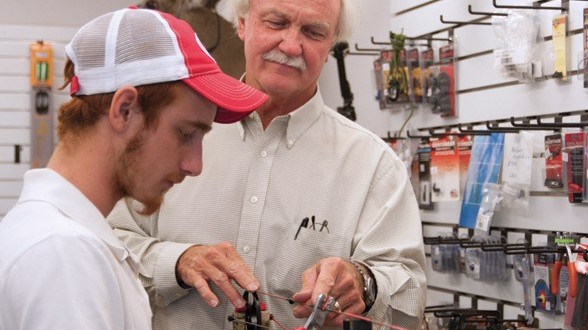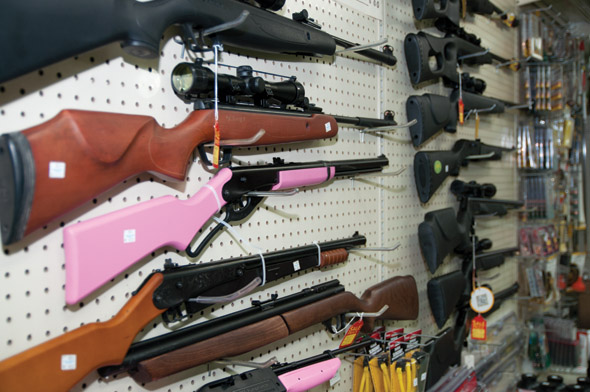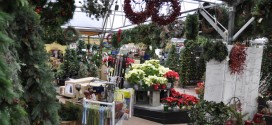Whether it be for a leisurely day of fishing or the thrill of camping and hunting wild game, these days, more and more consumers are headed outdoors to enjoy the elements.
Even with the economic recession causing many sectors to contract, the outdoor recreation economy grew approximately 5 percent annually between 2005 and 2011, according to the Outdoor Industry Association. And as of 2012, Americans were spending more than $121 billion on outdoor recreational products across all retail sectors each year.
This renewed interest in the outdoors can be a great opportunity for home improvement retailers, too. Hunting, fishing and other outdoor gear would fit right in at a home improvement store, where those categories that at one time played a large role in the industry are making a comeback.
Looking for a way to incorporate the sporting goods category in your store but aren’t quite sure where to begin? Hardware Retailing editors asked two outdoor-enthusiasts-turned retailers—Steve Soulam of Mountain Hardware & Sports in Truckee, Calif., and Nelson Wingo, owner of Campbell Hardware & Sporting Goods in Robertsdale, Ala.—what it takes to run a successful sporting goods department in a home improvement store setting.
Read on to learn what they say works for their markets and what they suggest other retailers should know before expanding into sporting goods in their own stores.
Mountain Hardware & Sports in Truckee, Calif.
Steve Soulam, sporting goods department manager
With a full selection of fishing equipment, clothing, hiking and backpacking gear and recreational equipment, this store caters to a wide demographic of local nature guides and sporting enthusiasts.
Hardware Retailing (HR): How much floor space do you dedicate to the sporting goods department in your store? How much merchandise do you stock?
Steve Soulam (SS): About 2,000 square feet of the 19,000-square-foot store is dedicated to the sporting goods category, which carries about 11,000 SKUs of merchandise. A lot of it is smallish merchandise, and not all of it is out on the floor at the same time—much of it swaps out with seasonal changes. For example, we wouldn’t have river float tubes and ice skates out at the same time.
The average customer purchase is $32 throughout the entire store, and the sporting goods category is within that range as well.
HR: How do you creatively merchandise the large number of SKUs in your inventory in such a small space?
SS: We pride ourselves on the variety of products we carry, so we are constantly rotating product on the floor. For example, salmon fishing products are out for the summer months for the height of that season, and in the winter we rotate out our air mattress display for items like ice skates and snowshoes. All products are available all season; we just try to keep things out we know people are searching for relevant to the seasons.
The sporting goods area also takes on a loose outdoor theme, with green carpet, wooded racking displays and canoes mounted high on display shelves.
HR: How do you decide which niche categories to stock in the sporting goods department?
SS: We are a fairly large fishing supply shop so it’s been an evolutionary process for us and we’ve been able to expand and fill in the specialty sporting goods niche. The alternative options for our customers are to travel 30 plus miles away to a big-box store, so we strive to provide what our customers need by keeping good dialogues with local guides and sporting enthusiasts.
In hunting, we supply clothing, accessories and ammunition. We also have gold-panning supplies, hiking gear and technical clothing, sleeping bags and other camping gear.
HR: Describe your customer base. How does that influence how you target your product mix?
SS: We have a pretty diverse customer base, from locals who have been shopping with us for 20 plus years, to second homeowners who make a point of shopping with us while in town, to the new visitors who are happily surprised by the variety of product we carry. Therefore we work hard to carry products to cover all needs.
We differentiate ourselves from the big boxes in that we offer firsthand knowledge of outdoor sporting activities in our area. Our sporting goods, hunting and fishing selection are really tied to the Truckee-Tahoe area, and all our employees represent several years of knowledge and experience in fishing, hunting, backpacking, camping and more.
HR: With such a variety of customers coming into the store, how do you promote the sporting goods department?
SS: We’re known as a destination store locally—a tourist attraction in addition to a hardware store. We have a unique situation in our department in that the whole store brings in such a large variety of customers. They come in for hardware sometimes and didn’t know we had a fishing department or even a home decor department.
We also promote the sporting goods department a lot with word-of-mouth and by advertising in select local outdoor magazines and online with our website to reach out to our more experienced outdoor enthusiasts.
We have an online weekly fishing report that includes what types of lure and bait are working and what kinds of fish can be found in certain areas, and we print it out to have on hand for customers who request it. We also write this kind of information on a dry erase board in the store.
We have close relationships with the North Lake Tahoe/Truckee Flyfishers and the local chapter of Trout Unlimited, so we get the store’s name out there that way, too.
We also support the local guides—we are their source for flies and other equipment for their clients. Many times guides will meet their clients in the sporting goods department, too. We meet a lot of potential customers that way.
HR: What is your background in sporting goods? What qualities make a strong candidate for a hire in this category?
SS: Our background in sporting goods comes from living it—being on the water, being outdoors. I’ve been with the store about five and half years, and like all of us who work in sporting goods, we come from diverse backgrounds, but we’re all fisherman and campers. There’s no better way to get experience than to be out there fishing or canoeing.
HR: How do you train employees to sell in this category?
SS: Training to gain the knowledge in selling sporting goods isn’t learned in traditional ways—you have to go out and live it on your own. All four of the employees in our department are fishing junkies, so they all have great outdoor experience. I’ve been an avid outdoorsman for more than 30 years, too. Having that firsthand knowledge lets you speak confidently to beginning anglers or experienced fishermen and sportsmen of all kinds.

Campbell Hardware & Sporting Goods, Robertsdale, Ala.
Nelson Wingo, owner, and Ashley Kucera, marketing manager
This store has full-service gunsmiths on staff, all of whom specialize in firearm cleaning, maintenance and repair and scope mounting. It also has a full-service archery shop and an extensive assortment of outdoor clothing and gear.
Hardware Retailing (HR): What is your background in sporting goods? What qualities make a strong candidate for a hire in this category?
Nelson Wingo (NW): We started the sporting goods department because it was a hobby of mine. What better way to have fun in this business than to open up a sporting goods shop?
Most of the people I have hired were people that were in hunting clubs with me or were people in the community I knew. My gunsmith, for example, started working for us when I decided doing repairs and maintenance work myself was more than I could handle. I found him from a call to a gunsmith school and asked them to post a job application for me.
HR: How do you train employees to sell in this category?
NW: We typically have between eight and 12 employees working in the store at any given time, with some working in the back on gun repairs. A lot of the people we hire to work in sporting goods have a skilled background in their field, but we do train all employees on working with customers.
We try to hire people who are knowledgeable in what they do. Once they’re hired, we’ll send them to training seminars and to the manufacturers’ factories to learn how to work with the products so they can truly become experts. A lot of the manufacturers are also good about having training seminars online.
HR: How much floor space do you dedicate to the sporting goods department in your store? How much merchandise do you stock?
NW: In the early ‘90s, I bought the building next door, so we moved our sporting goods over there. We started out with a small 1,200-square-foot space, then we eventually expanded to 2,000 square feet. Now, pretty much the whole 7,000-square-foot store on that side of the building is used for either display purposes or storage for sporting goods.
At last count, we ran somewhere between 18,000 and 20,000 SKUs just in sporting goods, which includes ammunition, fishing tackle, archery, optics, clothing, marine and hardware. We try to have a general spread in all departments.
Ashley Kucera (AK): We’ve also built a new addition with a shooting lane and repair shop on the salesfloor so bow technicians can better interact with customers. With this setup, they can talk to customers while they’re making repairs. It not only saves the technician time from having to go back and forth, but it also put a face with that department.
HR: Describe your customer base. How does that influence how you target your product mix and promote products?
NW: It’s a variety. Most in our rural area are pretty knowledgeable when it comes to sporting goods, but we’ve got a few novice customers who move into the area.
We have a pretty even mix of men and women coming in looking for guns, too. We’ve teamed up with the sheriff’s department to hold gun seminars, where they tell consumers what they need to be compliant with local firearms ownership and usage laws. We host a range day for anyone who buys a gun and wants hands-on training.
As for product mix, I do depend on my sales reps a lot. When I was starting out and didn’t know what I wanted to carry, they took me to different stores to see how they set things up and how we could adapt a similar model in our market and square footage.
Especially in the gun and optics industry, if I’m looking to stock something that’s hard to find, the sales reps work with other stores and see if they’d be willing to make a trade if it’s something that’s not moving for them. We also send things out and sell to other stores at cost if it’s something that’s not moving for us. We don’t make anything on it, but when I need something from another retailer in the region, they’re more willing to sell to me at cost, too.
HR: How do you promote the sporting goods department?
AK: We do a lot of community service activities, including sponsoring a game night with a local elementary school as a way of promoting hunting and shooting safety. We’re also very involved in local sporting and gun clubs and sponsor a couple local TV shows. The more we go to the schools, churches and city groups, the more it generates traction for the store. They tend to support us because we support them.
We’re active on social media, too, and found our customers visiting our Facebook page like to see people. Any time I mention or post a photo of an employee or customer, I have more comments than if I would’ve posted a picture of merchandise.
NW: We also work with local schools with their archery training programs, which has really caught on in the last two years. Our bow technicians will work with the students on basic archery skills and help them prepare for archery tournaments and target shoots.
HR: How do you stay competitive with the big-box hardware and sporting goods stores in your market?
NW: A lot of the companies we work with utilize minimum advertised price (MAP) pricing, so everybody sells everything for the same price. A lot of the low-margin items we sell, like guns, utilize MAP pricing, so we have a set price we can’t sell below, which helps us a lot with the big boxes.
HR: What advice would you give to retailers interested in starting a sporting goods department?
NW: If you want to get into sporting goods, you’ve got to enjoy the sport. You cannot be a success if you’re not a hands-on operator.
Also, talk with your sales reps, research your market and start small—don’t overextend yourself. When I first started with sporting goods, I felt it was better to expand into something larger than have to minimize and cut back. If you build something grandiose and it doesn’t work right, it leaves a negative impact with your customers. If you start with a small space and then keep expanding, to your customers, it shows them you’ve got something good going on.
Four Ways to Create a Stand-out Sporting Goods Department
Thinking of adding sporting goods to your store? You’ll have the most success if you do the following things well, say Kucera and Wingo.
Partner with local organizations (i.e. schools, churches, police departments).
“The more we go to the schools, churches and city groups, the more it generates traction for the store. The community tends to support us because we support it,” Kucera says.
Offer special services and seminars (i.e. bow and gun repairs and hunting licenses).
Although some services, like selling hunting licenses, won’t make you any profit, once the customer is in your store, you can upsell them on your store’s latest hunting or fishing items.
Offer highly localized assortments catered to your region and customers’ interests.
Get to know your market and customers. Success in this category depends on the volume and type of hunting, fishing and camping going on in the area.
Hire expertly trained employees and/or train current staff.
Employees need to know how to talk to customers of all experience levels through an entire purchase, especially if they’re coming to your store to buy highly specialized equipment such as guns.
 Hardware Retailing The Industry's Source for Insights and Information
Hardware Retailing The Industry's Source for Insights and Information











